Biohabitats Projects, Places & People
By Amy Nelson
Projects
As some of you may know, we recently launched a research and development practice within Biohabitats, called Bioworks. We have been busy at work meeting with potential collaborators (check out the great research work that the folks at Kieran Timberlake are doing), exploring ways to embed more research into the applied work we do, and developing an adaptive strategy plan to guide our research and development efforts for the next three years. We would love to hear about your ideas for advancing the research and development of conservation planning, ecological restoration and regenerative design. Give us a call or send us an email.
Restoring Fish Passage, Floodplain Connection, and Tidal Processes in the Pacific Northwest
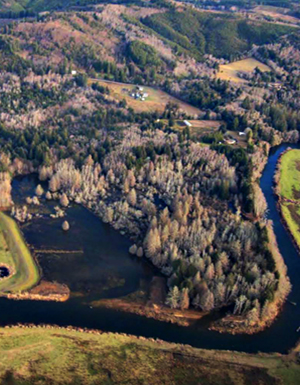
For anadromous fish species like Coho Salmon (Oncorhynchus kisutch), the Columbia River Estuary is like Grand Central Station, a dynamic hub that provides important migratory pathways to freshwater spawning areas and important rearing habitat for outmigrating juveniles. But a century’s worth of modifications to the Columbia River in the name of hydroelectric power, flood control, and agriculture, and the resulting loss and degradation of tidal wetlands has rendered many of those important habitat complexes inaccessible.
This winter, Biohabitats worked with the Columbia River Estuary Study Taskforce (CREST) to re-connect the 46-acre Fee-Simon Wetland to the natural tidal process of the region. A levee had confined a portion of the South Fork of the Klaskanine River and disconnected it from its historic floodplain. For salmonids, the confined structure of the leveed channel, along with the swift, uniform flow of its water, presented a challenge for rearing. Biohabitats helped CREST breach the levee in five locations and re-connect the backwater channel networks to the South Fork Klaskanine River to restore the tidal processes.

To improve the fish habitat, Biohabitats placed large, woody debris into the backwater channel network to create refuges for juvenile fish and pools of slow-moving water with rich foraging opportunities. Perhaps most importantly, restoration brought the floodplain and isolated wetlands back into contact with the river’s main channel. This project had a wide array of energetic project stakeholders, including the Natural Resource Conservation Service, and we are proud to have helped them bring it to life.

Tidal Marsh Restoration Has Great Hook for Migratory Birds
The 10,144-acre Prime Hook Wildlife Refuge, located along the western shore of the Delaware Bay, was established specifically as a sanctuary for migratory birds traveling up and down the Atlantic Flyway. More than 300 species of birds thrive in the Refuge’s mosaic of diverse habitats. When Superstorm Sandy severely damaged a large area of the Refuge’s tidal marsh, the U.S. Fish and Wildlife Service turned to Biohabitats for help.

Through an IDIQ contract with the National Park Service, Biohabitats was selected to plant 261,400 Spartina alterniflora plugs across 13.5 acres of the damaged area. The installation of these wetland plants and goose exclusion fencing to protect the young plants was completed earlier this spring. Biohabitats oversaw the work which was completed by subcontractors Ecological Restoration & Management, and we will continue to monitor the area throughout the growing season to ensure a successful project for the federal government. This planting is the initial phase of a larger comprehensive resiliency project planned for completion by November 2016 .
Foundation Lives Its Mission in Potomac River Watershed

At the 330-acre Hard Bargain Farm environmental educational center, located along the Potomac River, the Alice Ferguson Foundation truly walks the walk when it comes to furthering their mission to connect people to the natural heritage of the Potomac River watershed. When the Foundation needed to replace the center’s overnight lodge and construct a new education building, they opted to pursue Living Building Challenge™ (LBC) certification, the most rigorous standard known for sustainability. Carefully harvesting, recycling and balancing water and nutrients is often one of the more challenging aspects of LBC certification. A conventional septic system originally proposed for managing greywater was not only prohibitively expensive, but required significant energy to pump water long distances to suitable drainfield area.

Biohabitats designed and permitted a greywater system that provides a low energy solution to safely recharge treated greywater back to the aquifer. The core of the system is a land application subsurface drip irrigation system that harnesses the power of the farm’s surrounding meadow to slowly filter, treat and percolate greywater through biologically active soils and plant roots. The system, the first of its kind in Prince George’s County, MD, treats more than 1,800 gallons of grey water per day and disperses it in a way that recharges the groundwater and protects the quality of water entering the Potomac River. It is also an educational model to help visitors learn about integrated water strategies and better understand the connections between human actions and local ecology. In this video, senior engineering technician Olin Christy describes the system.
 Innovation Can Be Slimy (in a good way)
Innovation Can Be Slimy (in a good way)
When your 540-acre marine terminal is associated with more than 1400 acres of impervious surface, you need to think very seriously and creatively when it comes to meeting required total maximum daily loads (TMDLs) for nutrients and sediment to satisfy your water quality permit. That is exactly what the Maryland Port Administration (MPA) did when it came to the Dundalk Marine Terminal, the largest general cargo facility at the Port of Baltimore. As part of the MPA’s Water Quality management Plan, intended to reduce the impact of stormwater runoff from the Port of Baltimore’s public marine terminals, the administration chose to pilot test the use of an Algal Turf Scrubber®, a technology that harnesses the power of attached filamentous algae to improve water quality.

With help from the Maryland Environmental Service, Biohabitats, the University of Maryland, Living Ecosystems; the Smithsonian Institution and Hydromentia, the MPA installed a 300-foot long scrubber at the Dundalk Marine Terminal in 2014. Since then, Biohabitats has been working with the University of Maryland’s Department of Environmental Science and Technology (ENST) to regularly harvest and analyze the algae. After 12 months of monitoring, the scrubber was deemed so effective at reducing nitrogen, phosphorous, and sediment loads that the MPA expects to upscale the system tenfold. The technology is also up for approval by the EPA’s Chesapeake Bay Program as a BMP for TMDL reduction. In the meantime, the scrubber has been recognized by the Chesapeake Stormwater Network as the 2014 Best Urban BMP in the Chesapeake Bay region and first place winner in the Innovation Category. It has also been used as a research site by ENST capstone students, whose testing of harvested algae in an anaerobic digester suggests that it is a viable clean energy source, and mixing with concrete has proved a useful way to sequester nutrients and carbon.
Regenerative Design Begins to Reverse Decades of Degradation
 Founded in 1980, the village of Dorsey’s Search in Columbia, MD grew quickly into a densely populated suburb. With that rapid development came…you guessed it…stormwater-related problems. Stormwater from the village’s retail hub and residential development caused severe erosion in a tributary to a stream that flows into the Little Patuxent River. Working with the Howard County Department of Public Works’ Stormwater Management Division, Biohabitats created a regenerative restoration design to stabilize the degrading tributary and reconnect it to its floodplain while also retrofitting four storm drain outfalls. The restoration involved the installation of cobble riffle structures in the channel, which raise the stream bed back up to pre-disturbance levels allowing storm flows to spill onto the forested floodplain, and create deeper pools in the channel. Large, woody debris placed in these deeper pools provides native fish habitat. Though challenged by the short distance and steep grade of the land between the outfalls and the forested floodplain, Biohabitats was able to craft a design to laterally distribute stormwater into terraced, wetland cells which detain and infiltrate the first flush of runoff from parking areas, streets, sidewalks, and roofs. In addition to improving water quality and stability, the restoration also replaces non-native trees and shrubs with native vegetation that will improve habitat in a densely populated suburban setting.
Founded in 1980, the village of Dorsey’s Search in Columbia, MD grew quickly into a densely populated suburb. With that rapid development came…you guessed it…stormwater-related problems. Stormwater from the village’s retail hub and residential development caused severe erosion in a tributary to a stream that flows into the Little Patuxent River. Working with the Howard County Department of Public Works’ Stormwater Management Division, Biohabitats created a regenerative restoration design to stabilize the degrading tributary and reconnect it to its floodplain while also retrofitting four storm drain outfalls. The restoration involved the installation of cobble riffle structures in the channel, which raise the stream bed back up to pre-disturbance levels allowing storm flows to spill onto the forested floodplain, and create deeper pools in the channel. Large, woody debris placed in these deeper pools provides native fish habitat. Though challenged by the short distance and steep grade of the land between the outfalls and the forested floodplain, Biohabitats was able to craft a design to laterally distribute stormwater into terraced, wetland cells which detain and infiltrate the first flush of runoff from parking areas, streets, sidewalks, and roofs. In addition to improving water quality and stability, the restoration also replaces non-native trees and shrubs with native vegetation that will improve habitat in a densely populated suburban setting.
Soon after being constructed this spring, the new wetland cells were already being used as habitat by toad tadpoles (Anaxyrus sp.), as you can see in this video.
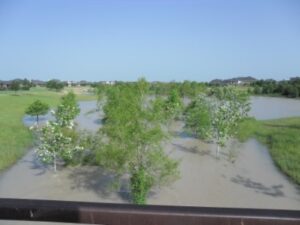
Restored Texas Creek Handles Heavy Spring Storms
Back in 2005, when we first began working with SWA Group and Brown & Gay Engineers to restore Flewellen Creek near Houston, TX, it was a virtually lifeless irrigation ditch. Today, with two phases of the three-stage restoration project complete, Flewellen Creek is a beautiful, ecologically functioning, naturally meandering channel within a broad floodplain. It is also the centerpiece of the Cross Creek Ranch development, where it is part of everyday life in the community. But the restored creek, its native riparian vegetation, and its creekside trails offer a lot more than the recreational and environmental education opportunities enjoyed by the community. They also provide important floodplain connectivity, as well as habitat for aquatic and terrestrial species, including raptors. The completed portions of the restoration also maintained stability and function throughout this spring’s heavy storms. Grading for the third phase of the restoration is slated for this year, and we look forward to seeing that little ‘ole ditch continue to transform into a healthy stream system.
Willow School’s New Health & Wellness Center: It’s Alive!

Caring for and experiencing the wonder of the natural world are integral to the mission at the Willow School, a 120-student independent day school in Gladstone, NJ. Earlier this spring, the school, which had already built a LEED Gold schoolhouse and LEED Platinum multi-purpose facility, opened up its new health and wellness center, designed according to Living Building Challenge standards, the most stringent third-party certified green building program available to date. We are proud to have collaborated with lead firm, Farewell Architects, LLC, as well as Joseph R. Loring and Associates, Inc., to design sustainable water infrastructure that is in line with the school’s philosophies. This includes onsite wastewater treatment and reuse, stormwater management, and rain harvesting and reuse. We’re delighted to know that all rainwater that falls on the newly opened wealth and wellness center, is not only captured and treated on site, but used to flush toilets in the building and to recharge the groundwater!
Kinda like the Oscars…for Stormwater and Sustainability

This spring seemed like awards season for ecological restoration, conservation planning and regenerative design. We’re proud to have been involved in these winners.
The Society for College and University Planning recognized Rowan University’s innovative integration of stormwater management and landscape master planning with a 2015 Merit Award for Excellence in Planning for an Existing Campus.
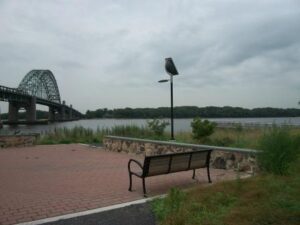
Lardner’s Point Park, an ecologically rich and sustainable greenway park we helped bring to life along 10 miles of the Delaware River in Pennsylvania, earned the Pennsylvania Department of Conservation and Natural Resources’ 2015 Green Park Award! The award recognizes Delaware River City Corporation and Pennsylvania Environmental Council’s excellence in green and sustainable park practices and efforts that connect people to nature across the state.

In April, the Chesapeake Stormwater Network presented its 2015 BUBBA Awards. BUBBA stands for Best Urban BMP in the (Chesapeake) Bay. The Daylighting of Broad Branch and Restoration of its Linnean Park Tributary not only won First Place in the category of Best Stream Restoration, but it was voted Best Urban BMP in the Chesapeake Bay region! We couldn’t be prouder, and neither could our partners, Underwood & Associates and Stantec. The system we designed with Big City Farms to capture and re‐use of hoop‐house roof runoff at Strength to Love Farm an urban‐agriculture site in Baltimore City, won First Place in the Best Innovative BMP category. The Baltimore Community Toolbank Raingardens and Blue Water Baltimore’s Baltimore Blue Alleys and Neighborhoods project received 3rd Place and Honorable mention, respectively, for Best Ultra-Urban BMP.
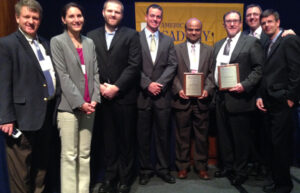
The restoration and remediation of Dover, Delaware’s Mirror Lake through the use of tidal wetland restoration and activated carbon earned an Honor Award for Excellence in Environmental Engineering and Science. Collaborators on this project led by the Delaware Department of Natural Resources and Environmental Control included the University of Maryland Baltimore County Department of Chemical, Biochemical, and Environmental Engineering and Brightfield.
Places

Biohabitats president Keith Bowers recently participated in, ‘Cities at the Edge: Changing Urban Conditions” a Plenary Session of the 21st International Symposium on Society and Resource Management, held in Charleston, SC. Keith was one of six panelists from around the country that explored the challenges and opportunities of researching, restoring and managing urban biodiversity and ecosystem services in our increasingly urbanized world.
Keith Bowers is heading to China! As a result of the Rio+20 Conference it was agreed a universal set Sustainable Development Goals should be developed to frame the agendas and policies of UN member States for the next 15 years. These goals are directed at ending poverty, improving the lives of the poor and increasing protection and restoration of the world’s ecosystems. Of the 17 goals, only 2 (SDGs 14 & 15) address our ecosystems. In recognition of the essential role these two goals play to the health and resiliency of our planet, the IUCN Commission on Ecosystem Management and the Chinese Forestry Administration have convened a three-day High Level Consultation in Guiyang, China June 24-27. The main purpose of the meeting is to provide the UN and member States with technically robust guidance on the importance and urgency of incorporating these two goals into the governance of our environment.

Landscape ecological designer and planner Jennifer Dowdell will head to the Windy City on July 11 to attend the annual gathering of the Society for College and University Planning professionals. Jennifer will proudly accompany our friends from Rowan University as they accept the 2015 SCUP Merit Award for Excellence in Planning for an Existing Campus. Jennifer is proud to represent our project team, which included Ayers Saint Gross and Urban Engineers.
The Rocky Mountain Stream Restoration Conference will take place on July 21-23 in Breckenridge, CO. Fluvial Geomorphologist Vince Sortman wouldn’t miss this one for the world!

From August 9-14, the Ecological Society of America will celebrate its 100th birthday at the organization’s annual meeting in Baltimore. During the conference, ecological engineer Chris Streb, along with other Biohabitats staff and our summer interns, will lead a project for the Earth Stewardship Initiative (ESI) at the conference. The goal of the effort is to bring the knowledge of ecologists, who are often merely observers of ecosystems, to the design table, where their knowledge can be applied to shape the trajectory of an ecosystem. Biohabitats will be focusing our efforts on the Middle Branch of the Patapsco River.
We are proud to support the Irvine Nature Center’s annual Native Plant Seminar and Sale on in Owings Mills, MD on August 22. Biohabitats president Keith Bowers will speak at the event. The event is a great opportunity to learn about the benefits of using native plants, and pick up some of your own at great prices!
The Society for Ecological Restoration International will hold the 2015 World Conference on Ecological Restoration in Manchester, UK August 23-27. This year’s gathering, which carries the theme “Towards resilient ecosystems: restoring the urban, the rural and the wild” will feature presenters from all over the world.” One of them will be Biohabitats senior ecologist, Joe Berg, who will present “Restoration of Lizardhill Sandmine Using Sand Seepage Wetlands.”

People
We’ve always known that ecological landscape designer, Andi Rutherford, has the knowledge, skills, and abilities to provide professional services, and now it is official. Congratulations to Andi for passing the Landscape Architecture Registration Examination (L.A.R.E.)!
All too often, summer internship experiences are summed up by the phrase “getting to know the copier room.” But for our summer interns, Jonathan Galka, a Yale University sophomore who is studying Ecology & Evolutionary biology, and Kyle Speed, a senior at the University of Maryland who is studying Environmental Science and Technology, it’s more like “getting to know the urban waterfront.” Jonathan and Kyle are developing a protocol to assess ecological function along Baltimore’s urban waterfront as part of the 2015 Earth Stewardship Initiative, this year’s demonstration project for the Ecological Society of America (ESA).
 Launched by Yale University in partnership with the ESA and other academic societies, agencies, and NGOs, the Earth Stewardship Initiative aims to engage natural and social scientists, designers, planners, policy makers and students in the development of strategies that foster a more sustainable trajectory of global change through linking social and ecological systems. The 2015 Earth Stewardship Initiative, “Cities that work for People and Ecosystems,” will take place during the ESA’s annual conference in Baltimore in August. The week-long project will challenge ecologists from across the U.S. to incorporate ecological science into grassroots urban planning and design. It is intended to stimulate research opportunities for ecologists and expose the powerful role ecologists can play in moving a city towards sustainability. Once honed through the demonstration project, the assessment tool being created by Jonathan and Kyle could potentially be adapted to other urban waterfronts throughout the U.S. Now that’s something worth copying.
Launched by Yale University in partnership with the ESA and other academic societies, agencies, and NGOs, the Earth Stewardship Initiative aims to engage natural and social scientists, designers, planners, policy makers and students in the development of strategies that foster a more sustainable trajectory of global change through linking social and ecological systems. The 2015 Earth Stewardship Initiative, “Cities that work for People and Ecosystems,” will take place during the ESA’s annual conference in Baltimore in August. The week-long project will challenge ecologists from across the U.S. to incorporate ecological science into grassroots urban planning and design. It is intended to stimulate research opportunities for ecologists and expose the powerful role ecologists can play in moving a city towards sustainability. Once honed through the demonstration project, the assessment tool being created by Jonathan and Kyle could potentially be adapted to other urban waterfronts throughout the U.S. Now that’s something worth copying.
Projects
Restoring Fish Passage, Floodplain Connection, and Tidal Processes in the Pacific Northwest
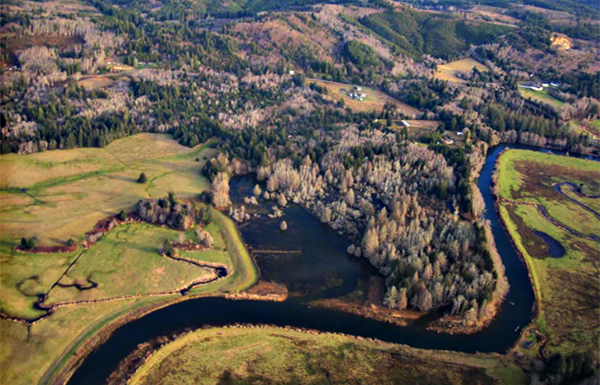
For anadromous fish species like Coho Salmon (Oncorhynchus kisutch), the Columbia River Estuary is like Grand Central Station, a dynamic hub that provides important migratory pathways to freshwater spawning areas and important rearing habitat for outmigrating juveniles. But a century’s worth of modifications to the Columbia River in the name of hydroelectric power, flood control, and agriculture, and the resulting loss and degradation of tidal wetlands has rendered many of those important habitat complexes inaccessible.
This winter, Biohabitats worked with the Columbia River Estuary Study Taskforce (CREST) to re-connect the 46-acre Fee-Simon Wetland to the natural tidal process of the region. A levee had confined a portion of the South Fork of the Klaskanine River and disconnected it from its historic floodplain. For salmonids, the confined structure of the leveed channel, along with the swift, uniform flow of its water, presented a challenge for rearing. Biohabitats helped CREST breach the levee in five locations and re-connect the backwater channel networks to the South Fork Klaskanine River to restore the tidal processes.
To improve the fish habitat, Biohabitats placed large, woody debris into the backwater channel network to create refuges for juvenile fish and pools of slow-moving water with rich foraging opportunities. Perhaps most importantly, restoration brought the floodplain and isolated wetlands back into contact with the river’s main channel. This project had a wide array of energetic project stakeholders, including the Natural Resource Conservation Service, and we are proud to have helped them bring it to life.
Tidal Marsh Restoration Has Great Hook for Migratory Birds
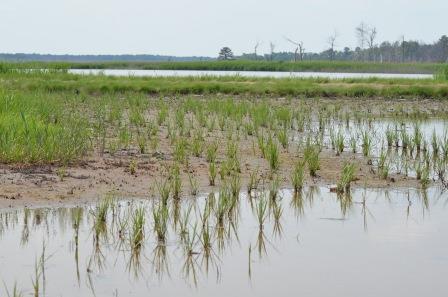
The 10,144-acre Prime Hook Wildlife Refuge, located along the western shore of the Delaware Bay, was established specifically as a sanctuary for migratory birds traveling up and down the Atlantic Flyway. More than 300 species of birds thrive in the Refuge’s mosaic of diverse habitats. When Superstorm Sandy severely damaged a large area of the Refuge’s tidal marsh, the U.S. Fish and Wildlife Service turned to Biohabitats for help.
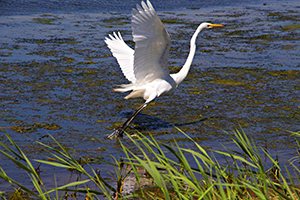
Through an IDIQ contract with the National Park Service, Biohabitats was selected to plant 261,400 Spartina alterniflora plugs across 13.5 acres of the damaged area. The installation of these wetland plants and goose exclusion fencing to protect the young plants was completed earlier this spring. Biohabitats oversaw the work which was completed by subcontractors Ecological Restoration & Management, and we will continue to monitor the area throughout the growing season to ensure a successful project for the federal government. This planting is the initial phase of a larger comprehensive resiliency project planned for completion by November 2016.
Foundation Lives Its Mission in Potomac River Watershed
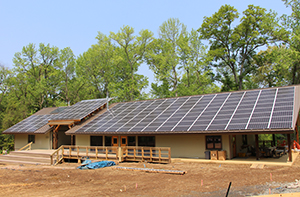
At the 330-acre Hard Bargain Farm environmental educational center, located along the Potomac River, the Alice Ferguson Foundation truly walks the walk when it comes to furthering their mission to connect people to the natural heritage of the Potomac River watershed. When the Foundation needed to replace the center’s overnight lodge and construct a new education building, they opted to pursue Living Building Challenge™ (LBC) certification, the most rigorous standard known for sustainability. Carefully harvesting, recycling and balancing water and nutrients is often one of the more challenging aspects of LBC certification. A conventional septic system originally proposed for managing greywater was not only prohibitively expensive, but required significant energy to pump water long distances to suitable drainfield area.
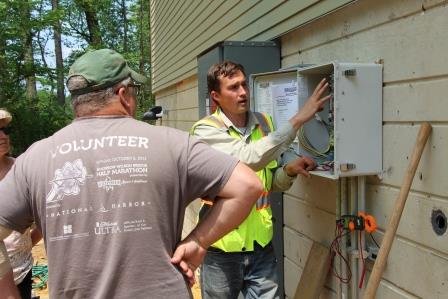
Biohabitats designed and permitted a greywater system that provides a low energy solution to safely recharge treated greywater back to the aquifer. The core of the system is a land application subsurface drip irrigation system that harnesses the power of the farm’s surrounding meadow to slowly filter, treat and percolate greywater through biologically active soils and plant roots. The system, the first of its kind in Prince George’s County, MD, treats more than 1,800 gallons of grey water per day and disperses it in a way that recharges the groundwater and protects the quality of water entering the Potomac River. It is also an educational model to help visitors learn about integrated water strategies and better understand the connections between human actions and local ecology. In this video, senior engineering technician Olin Christy describes the system.
Innovation Can Be Slimy (in a good way)
When your 540-acre marine terminal is associated with more than 1400 acres of impervious surface, you need to think very seriously and creatively when it comes to meeting required total maximum daily loads (TMDLs) for nutrients and sediment to satisfy your water quality permit. That is exactly what the Maryland Port Administration (MPA) did when it came to the Dundalk Marine Terminal, the largest general cargo facility at the Port of Baltimore. As part of the MPA’s Water Quality management Plan, intended to reduce the impact of stormwater runoff from the Port of Baltimore’s public marine terminals, the administration chose to pilot test the use of an Algal Turf Scrubber®, a technology that harnesses the power of attached filamentous algae to improve water quality.
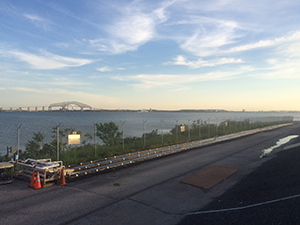
With help from the Maryland Environmental Service, Biohabitats, the University of Maryland, Living Ecosystems; the Smithsonian Institution and Hydromentia, the MPA installed a 300-foot long scrubber at the Dundalk Marine Terminal in 2014. Since then, Biohabitats has been working with the University of Maryland’s Department of Environmental Science and Technology (ENST) to regularly harvest and analyze the algae. After 12 months of monitoring, the scrubber was deemed so effective at reducing nitrogen, phosphorous, and sediment loads that the MPA expects to upscale the system tenfold. The technology is also up for approval by the EPA’s Chesapeake Bay Program as a BMP for TMDL reduction. In the meantime, the scrubber has been recognized by the Chesapeake Stormwater Network as the 2014 Best Urban BMP in the Chesapeake Bay region and first place winner in the Innovation Category. It has also been used as a research site by ENST capstone students, whose testing of harvested algae in an anaerobic digester suggests that it is a viable clean energy source, and mixing with concrete has proved a useful way to sequester nutrients and carbon.
Regenerative Design Begins to Reverse Decades of Degradation
Founded in 1980, the village of Dorsey’s Search in Columbia, MD grew quickly into a densely populated suburb. With that rapid development came…you guessed it…stormwater-related problems. Stormwater from the village’s retail hub and residential development caused severe erosion in a tributary to a stream that flows into the Little Patuxent River. Working with the Howard County Department of Public Works’ Stormwater Management Division, Biohabitats created a regenerative restoration design to stabilize the degrading tributary and reconnect it to its floodplain while also retrofitting four storm drain outfalls. The restoration involved the installation of cobble riffle structures in the channel, which raise the stream bed back up to pre-disturbance levels allowing storm flows to spill onto the forested floodplain, and create deeper pools in the channel. Large, woody debris placed in these deeper pools provides native fish habitat. Though challenged by the short distance and steep grade of the land between the outfalls and the forested floodplain, Biohabitats was able to craft a design to laterally distribute stormwater into terraced, wetland cells which detain and infiltrate the first flush of runoff from parking areas, streets, sidewalks, and roofs. In addition to improving water quality and stability, the restoration also replaces non-native trees and shrubs with native vegetation that will improve habitat in a densely populated suburban setting.
Soon after being constructed this spring, the new wetland cells were already being used as habitat by toad tadpoles (Anaxyrus sp.), as you can see in this video.
Restored Texas Creek Handles Heavy Spring Storms
 Back in 2005, when we first began working with SWA Group and Brown & Gay Engineers to restore Flewellen Creek near Houston, TX, it was a virtually lifeless irrigation ditch. Today, with two phases of the three-stage restoration project complete, Flewellen Creek is a beautiful, ecologically functioning, naturally meandering channel within a broad floodplain. It is also the centerpiece of the Cross Creek Ranch development, where it is part of everyday life in the community. But the restored creek, its native riparian vegetation, and its creekside trails offer a lot more than the recreational and environmental education opportunities enjoyed by the community. They also provide important floodplain connectivity, as well as habitat for aquatic and terrestrial species, including raptors. The completed portions of the restoration also maintained stability and function throughout this spring’s heavy storms. Grading for the third phase of the restoration is slated for this year, and we look forward to seeing that little ‘ole ditch continue to transform into a healthy stream system.
Back in 2005, when we first began working with SWA Group and Brown & Gay Engineers to restore Flewellen Creek near Houston, TX, it was a virtually lifeless irrigation ditch. Today, with two phases of the three-stage restoration project complete, Flewellen Creek is a beautiful, ecologically functioning, naturally meandering channel within a broad floodplain. It is also the centerpiece of the Cross Creek Ranch development, where it is part of everyday life in the community. But the restored creek, its native riparian vegetation, and its creekside trails offer a lot more than the recreational and environmental education opportunities enjoyed by the community. They also provide important floodplain connectivity, as well as habitat for aquatic and terrestrial species, including raptors. The completed portions of the restoration also maintained stability and function throughout this spring’s heavy storms. Grading for the third phase of the restoration is slated for this year, and we look forward to seeing that little ‘ole ditch continue to transform into a healthy stream system.
Willow School’s New Health & Wellness Center: It’s Alive!
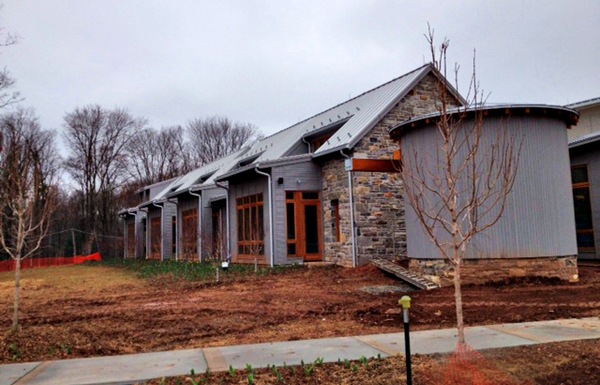
Caring for and experiencing the wonder of the natural world are integral to the mission at the Willow School, a 120-student independent day school in Gladstone, NJ. Earlier this spring, the school, which had already built a LEED Gold schoolhouse and LEED Platinum multi-purpose facility, opened up its new health and wellness center, designed according to Living Building Challenge standards, the most stringent third-party certified green building program available to date. We are proud to have collaborated with lead firm, Farewell Architects, LLC, as well as Joseph R. Loring and Associates, Inc., to design sustainable water infrastructure that is in line with the school’s philosophies. This includes onsite wastewater treatment and reuse, stormwater management, and rain harvesting and reuse. We’re delighted to know that all rainwater that falls on the newly opened wealth and wellness center, is not only captured and treated on site, but used to flush toilets in the building and to recharge the groundwater!
Kinda like the Oscars…for Stormwater and Sustainability
This spring seemed like awards season for ecological restoration, conservation planning and regenerative design. We’re proud to have been involved in these winners.
The Society for College and University Planning recognized Rowan University’s innovative integration of stormwater management and landscape master planning with a 2015 Merit Award for Excellence in Planning for an Existing Campus.
Lardner’s Point Park, an ecologically rich and sustainable greenway park we helped bring to life along 10 miles of the Delaware River in Pennsylvania, earned the Pennsylvania Department of Conservation and Natural Resources’ 2015 Green Park Award! The award recognizes Delaware River City Corporation and Pennsylvania Environmental Council’s excellence in green and sustainable park practices and efforts that connect people to nature across the state.
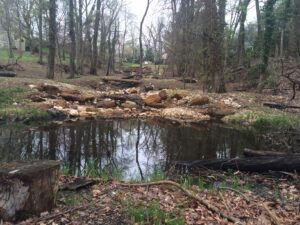
In April, the Chesapeake Stormwater Network presented its 2015 BUBBA Awards. BUBBA stands for Best Urban BMP in the (Chesapeake) Bay. The Daylighting of Broad Branch and Restoration of its Linnean Park Tributary not only won First Place in the category of Best Stream Restoration, but it was voted Best Urban BMP in the Chesapeake Bay region! We couldn’t be prouder, and neither could our partners, Underwood & Associates and Stantec. The system we designed with Big City Farms to capture and re‐use of hoop‐house roof runoff at Strength to Love Farm an urban‐agriculture site in Baltimore City, won First Place in the Best Innovative BMP category. The Baltimore Community Toolbank Raingardens and Blue Water Baltimore’s Baltimore Blue Alleys and Neighborhoods project received 3rd Place and Honorable mention, respectively, for Best Ultra-Urban BMP.
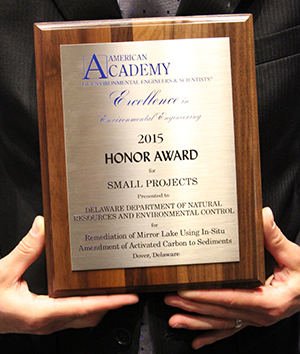 The restoration and remediation of Dover, Delaware’s Mirror Lake through the use of tidal wetland restoration and activated carbon earned an Honor Award for Excellence in Environmental Engineering and Science. Collaborators on this project led by the Delaware Department of Natural Resources and Environmental Control included the University of Maryland Baltimore County Department of Chemical, Biochemical, and Environmental Engineering and Brightfield.
The restoration and remediation of Dover, Delaware’s Mirror Lake through the use of tidal wetland restoration and activated carbon earned an Honor Award for Excellence in Environmental Engineering and Science. Collaborators on this project led by the Delaware Department of Natural Resources and Environmental Control included the University of Maryland Baltimore County Department of Chemical, Biochemical, and Environmental Engineering and Brightfield.
Places
Biohabitats president Keith Bowers recently participated in, ‘Cities at the Edge: Changing Urban Conditions” a Plenary Session of the 21st International Symposium on Society and Resource Management, held in Charleston, SC. Keith was one of six panelists from around the country that explored the challenges and opportunities of researching, restoring and managing urban biodiversity and ecosystem services in our increasingly urbanized world.
Keith Bowers is heading to China! As a result of the Rio+20 Conference it was agreed a universal set Sustainable Development Goals should be developed to frame the agendas and policies of UN member States for the next 15 years. These goals are directed at ending poverty, improving the lives of the poor and increasing protection and restoration of the world’s ecosystems. Of the 17 goals, only 2 (SDGs 14 & 15) address our ecosystems. In recognition of the essential role these two goals play to the health and resiliency of our planet, the IUCN Commission on Ecosystem Management and the Chinese Forestry Administration have convened a three-day High Level Consultation in Guiyang, China June 24-27. The main purpose of the meeting is to provide the UN and member States with technically robust guidance on the importance and urgency of incorporating these two goals into the governance of our environment.
Landscape ecological designer and planner Jennifer Dowdell will head to the Windy City on July 11 to attend the annual gathering of the Society for College and University Planning professionals. Jennifer will proudly accompany our friends from Rowan University as they accept the 2015 SCUP Merit Award for Excellence in Planning for an Existing Campus. Jennifer is proud to represent our project team, which included Ayers Saint Gross and Urban Engineers.
The Rocky Mountain Stream Restoration Conference will take place on July 21-23 in Breckenridge, CO. Fluvial Geomorphologist Vince Sortman wouldn’t miss this one for the world!
From August 9-14, the Ecological Society of America will celebrate its 100th birthday at the organization’s annual meeting in Baltimore. During the conference, ecological engineer Chris Streb, along with other Biohabitats staff and our summer interns, will lead a project for the Earth Stewardship Initiative (ESI) at the conference. The goal of the effort is to bring the knowledge of ecologists, who are often merely observers of ecosystems, to the design table, where their knowledge can be applied to shape the trajectory of an ecosystem. Biohabitats will be focusing our efforts on the Middle Branch of the Patapsco River.
We are proud to support the Irvine Nature Center’s annual Native Plant Seminar and Sale on in Owings Mills, MD on August 22. Biohabitats president Keith Bowers will speak at the event. The event is a great opportunity to learn about the benefits of using native plants, and pick up some of your own at great prices!
The Society for Ecological Restoration International will hold the 2015 World Conference on Ecological Restoration in Manchester, UK August 23-27. This year’s gathering, which carries the theme “Towards resilient ecosystems: restoring the urban, the rural and the wild” will feature presenters from all over the world.” One of them will be Biohabitats senior ecologist, Joe Berg, who will present “Restoration of Lizardhill Sandmine Using Sand Seepage Wetlands.”
People
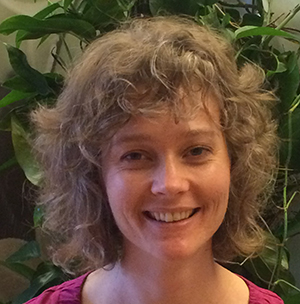
We’ve always known that ecological landscape designer, Andi Rutherford, has the knowledge, skills, and abilities to provide professional services, and now it is official. Congratulations to Andi for passing the Landscape Architecture Registration Examination (L.A.R.E.)!
All too often, summer internship experiences are summed up by the phrase “getting to know the copier room.” But for our summer interns, Jonathan Galka, a Yale University sophomore who is studying Ecology & Evolutionary biology, and Kyle Speed, a senior at the University of Maryland who is studying Environmental Science and Technology, it’s more like “getting to know the urban waterfront.” Jonathan and Kyle are developing a protocol to assess ecological function along Baltimore’s urban waterfront as part of the 2015 Earth Stewardship Initiative, this year’s demonstration project for the Ecological Society of America (ESA).
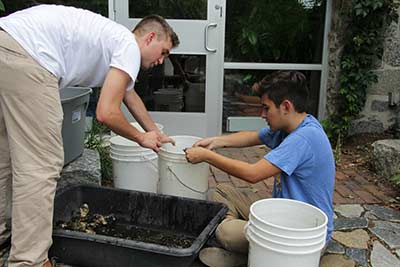
Launched by Yale University in partnership with the ESA and other academic societies, agencies, and NGOs, the Earth Stewardship Initiative aims to engage natural and social scientists, designers, planners, policy makers and students in the development of strategies that foster a more sustainable trajectory of global change through linking social and ecological systems. The 2015 Earth Stewardship Initiative, “Cities that work for People and Ecosystems,” will take place during the ESA’s annual conference in Baltimore in August. The week-long project will challenge ecologists from across the U.S. to incorporate ecological science into grassroots urban planning and design. It is intended to stimulate research opportunities for ecologists and expose the powerful role ecologists can play in moving a city towards sustainability. Once honed through the demonstration project, the assessment tool being created by Jonathan and Kyle could potentially be adapted to other urban waterfronts throughout the U.S. Now that’s something worth copying.

